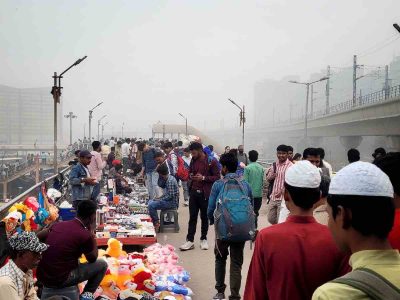In its 2025–26 budget, the Delhi government announced a Rs 9,000-crore allocation for water and sanitation—the largest to date.
Of this, Rs 500 crore has been earmarked for the Yamuna River’s rejuvenation, aligning with Prime Minister Narendra Modi’s earlier promise to prioritise its clean-up.
Chief Minister Rekha Gupta, while presenting the budget, reaffirmed the government’s commitment to the river.
“Our dedication to cleaning the Yamuna remains steadfast,” she said. “This is more than just a budget allocation—it is a pledge to the people of Delhi.”
She also called the Yamuna “a symbol of our heritage” and a central priority for the administration.
Mixed reactions from experts
Despite these ambitious budget announcements and reassurances from the Chief Minister, the government’s plans have drawn mixed responses from environmental experts.
Experts are divided on the Delhi government’s plan to clean the Yamuna River and upgrade sewage infrastructure.
The initiative includes constructing 40 decentralised sewage treatment plants (STPs), modernising existing ones, and deploying advanced machinery to tackle waste and pollution.
However, many stress that the government must monitor the quality of treated water from these plants to ensure it meets Central Pollution Control Board (CPCB) standards.
Plans stuck on paper since 2022
Pankaj Kumar, an environmentalist, said that while the new administration is holding regular meetings and site visits, the promise to build decentralised STPs has remained largely on paper since 2022.
“We appreciate that the government is working in the right direction to upgrade the STPs,” he told Patriot. “But to date, no action has been taken on the ground.”
He pointed out that authorities have long claimed that the combination of existing and planned STPs would allow the city to treat 964.5 million gallons per day (MGD)—the amount of wastewater Delhi generates.
“Namami Gange claimed that after December 2022, not even a single drop of untreated wastewater would be dumped into the Yamuna. But three years later, untreated water is still flowing directly into the river,” he said.
Now, authorities have revised the target to December 2026. Kumar called on the government to stick to its new deadline.
Compliance and monitoring remain weak
He added that even upgraded STPs are currently failing to meet the CPCB’s discharge standards.
“Only building the DSTPs and STPs will not be useful if we are not able to monitor their outlet water quality,” Kumar warned. “Authorities must regularly track every STP if they genuinely want to clean the Yamuna.”
Old approach, little impact
Bhim Singh Rawat, Associate Coordinator at the South Asia Network on Dams, Rivers and People (SANDRP), expressed concern that the budget once again fails to offer real hope.
He noted that similar investments in the past have not yielded results, with pollution levels in the river worsening each year.
“No accountability has been fixed for these failures, and the crucial aspect of river governance remains ignored,” he said.
Rawat added that addressing the Yamuna’s problems will require tackling multiple pollution sources—domestic sewage, industrial discharge, and solid waste dumping.
Yet, the Delhi government still lacks an integrated urban water policy, he said, calling this an essential but repeatedly overlooked step.
Ignored recommendations, missing deadlines
He further pointed out that the plan lacks deadlines or measurable targets.
“Instead of simply treating sewage, the government should focus on reusing treated water—for irrigation, industrial use, and city cleaning,” Rawat said.
Also Read: Delhi: Illegal sand mining continues unchecked, damage Yamuna
He criticised the budget for failing to act on parliamentary recommendations such as setting up District Yamuna Committees, a Clean Yamuna Fund, and a public platform to monitor floodplain encroachments and wetland degradation.
Rawat emphasised that a lasting revival of the river requires treating it as a living ecosystem.
“This means restoring its natural flow, reviving aquatic life, and maintaining its connectivity,” he said.
Pollutants entering upstream of the Wazirabad barrage continue to threaten drinking water and the overall health of the river, he added.
No clear roadmap, no reforms
He described the new budget as offering no meaningful reforms, instead allocating more funds to activities that have failed in the past.
“No clear timeline has been set, raising doubts about the government’s commitment to real change,” he said.
Rawat also called for stronger political will, greater transparency, and meaningful public participation.
He stressed the need for an urban water policy that includes rainwater harvesting, decentralised STPs, and conservation of water bodies.
“There is neither funding nor a roadmap for ensuring environmental flow in the river,” he said. “With excessive water diversions, the Yamuna is turning into a seasonal river. Expanding Delhi’s water supply must not come at the cost of the river’s survival.”
Request for central support and tourism initiatives
Beyond the state budget, the Delhi government has sought Rs 2,000 crore from the central government to upgrade the city’s water and sewage infrastructure to international standards.
Additionally, to boost tourism and recreational opportunities along the Yamuna, the government has proposed a Public-Private Partnership (PPP) initiative to launch boat tours between Sonia Vihar and Jagatpur Shani Mandir.
The success of these initiatives in cleaning the Yamuna River will depend heavily on effective implementation, seamless coordination among agencies, and active public engagement.





